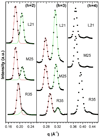Orientation of tie-lines in the phase diagram of DOPC/DPPC/cholesterol model biomembranes
- PMID: 20968281
- PMCID: PMC2978278
- DOI: 10.1021/la103024f
Orientation of tie-lines in the phase diagram of DOPC/DPPC/cholesterol model biomembranes
Abstract
We report the direction of tie-lines of coexisting phases in a ternary diagram of DOPC/DPPC/cholesterol lipid bilayers, which has been a system of interest in the discussion of biological rafts. For coexisting Ld and Lo phases, we find that the orientation angle α of the tie-lines increases as the cholesterol concentration increases and it also increases as temperature increases from T = 15 °C to T = 30 °C. Results at lower cholesterol concentrations support the existence of a different two-phase coexistence region of Ld and So phases and the existence of a three-phase region separating the two two-phase regions. Our method uses the X-ray lamellar D-spacings observed in oriented bilayers as a function of varying hydration. Although this method does not obtain the ends of the tie-lines, it gives precise values (±1°) of their angles α in the ternary phase diagram.
Figures








References
Publication types
MeSH terms
Substances
Grants and funding
LinkOut - more resources
Full Text Sources
Medical
Research Materials
Miscellaneous

